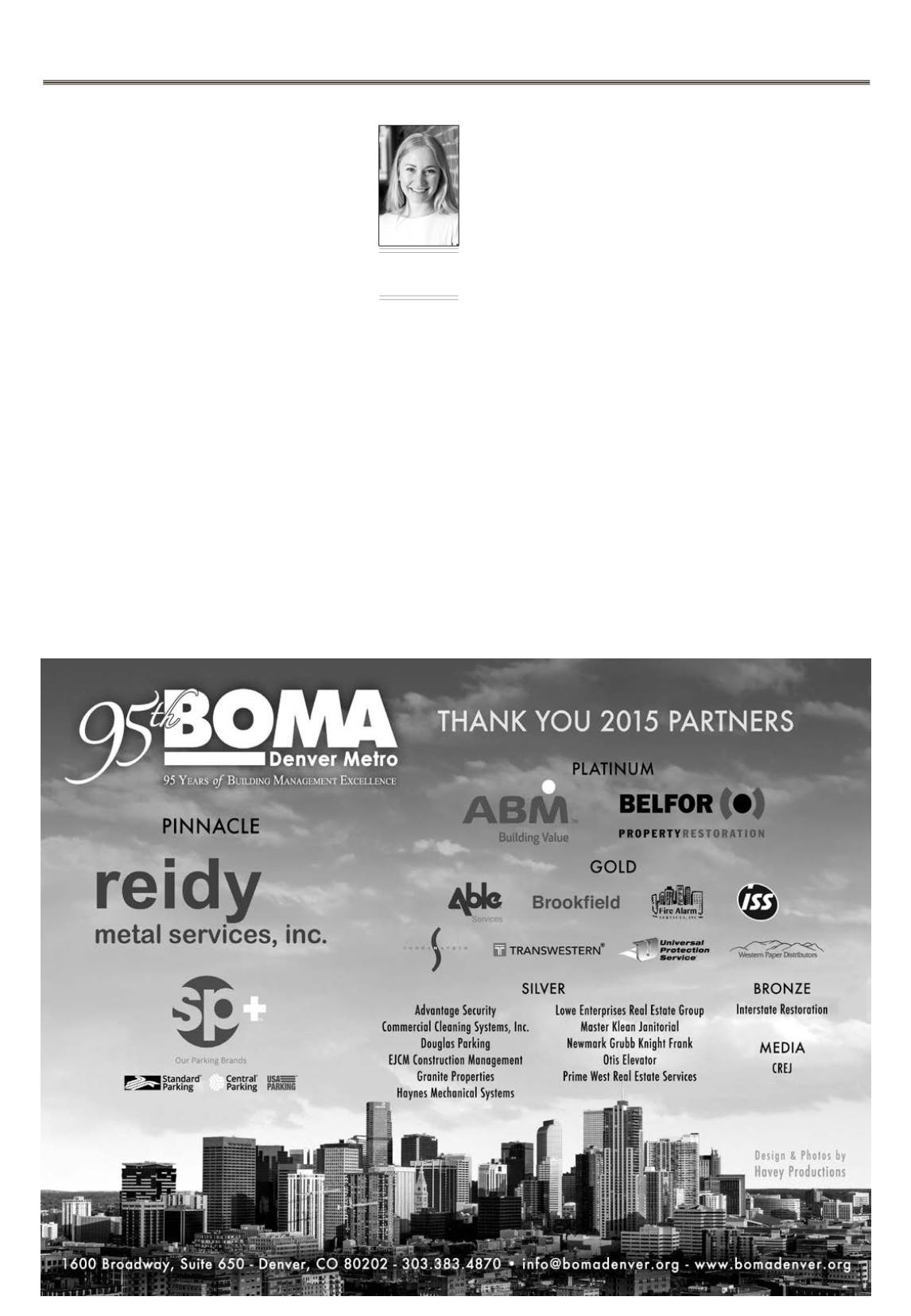
Page 34 —
COLORADO REAL ESTATE JOURNAL
— May 18-May 31, 2016
G
reen buildings always
have been a hotbed for
innovation and at this
year’s Rocky Mountain Green,
the largest green building
conference in the region,
emerging technologies and new
U.S. Green Building Council
initiatives took center stage.
Taking place on Earth Day, the
conference convened over 500
industry professionals across
varied sectors and showcased 30
exhibitors.
The focus of transforming
communities where we live,
work, learn and play was a focal
point of the conference with
over 20 sessions that provided
attendees with inspiration and
excitement for new technologies
in the industry.
“The survival of our species
depends on how sustainable we
make our cities,” said Ignacio
Correra-Ortiz with Regional
Transportation District.
The new 22.8-mile Colorado
A Line linking the Denver
International Airport to Denver
Union Station in the heart of
the city opened on the same
weekend as the conference.
RTD FasTracks raised industry
standards by implementing
different sustainable ideas and
technologies to make the RTD
Commuter Rail Maintenance
Facility LEED Gold certified.
The facility includes efficient
mechanics and lights for a 32
percent energy savings, water-
efficient plumbing fixtures for
a 39 percent reduction in water
use, radiant floor heating served
by an 89 percent efficient water
boiler and specially designed
windows that prevent thermal
transfer.
The industry also reported
seeing an emerging interest in
the WELL building standard,
which focuses on the health
and well-being of a building’s
occupants. WELL is composed
of over 100 features that are
applied to each building project,
and each feature is designed to
address issues that impact the
health, comfort or knowledge
of occupants. Many WELL
features intended to improve
health are supported by existing
government standards or other
standards-setting organizations.
Some features are intended
to change behavior through
education and corporate
policy or culture, and provide
information and support for
making positive lifestyle choices.
“The building industry has
the skills and technologies,
today, to create high-performing
buildings,” said Rachel
Bannon-Godfrey, director of
sustainability at RNL Design.
“The more important question
is what is needed for high-
performing people in these
buildings? The current health
and well-being revolution finally
brings the human aspect of
sustainability to the forefront.”
After
a huge
undertaking
that took over
four years,
the Aspen
Community
School was
successful
in earning a
$4.1 million
BEST Grant
in 2013,
as well as
reaching
key milestones in an intensive
fundraising campaign. The
efforts have made it possible
for ACS to complete various
campus renovations and
construct a replacement
gymnasium and K-8 classroom
building, both seeking LEED
for Schools Gold certification.
“During the planning,
design and construction, it was
apparent that project success
would only be possible with
an effective fusion of three
aspects: design, to engage
the buildings to the beautiful
campus surroundings; culture,
to reflect the exceptional history
of community and academic
excellence; and performance
of systems to minimize energy
use and cost,” said Kari-Elin
Mock, associate principal
with Cuningham Group
Architecture. “The result is a
very special facility that can
serve as inspiration for many
projects in the Rocky Mountain
region.”
Recent climate change
impacts are increasing
demand for the adoption of
environmental, social and
governance initiatives. Investors
and tenants are creating
a greater push for more
energy- and water-efficiency
investments, climate change
resilience preparedness, and
workplace health safety and
productivity. As ESG becomes
increasingly important,
investors and regional and
national regulators will
progressively mandate greater
transparency in these topics
from the real estate sector.
GBCI’s recently acquired
Global Real Estate
Sustainability Benchmark is an
industry-driven organization
committed to assessing the
sustainability performance of
real estate portfolios around
the globe. While LEED is
the measure of an asset’s
performance, GRESB is
the measure of a real estate
portfolio’s performance. GRESB
was created in response to large
investors who continue to call
for more robust sustainability
analytics, a desire founded in
research that continues to tie
sustainability to higher returns
and performance.
The conference explored
the requirements of GRESB
reporting and the relevancy to
those in property management,
development, design,
construction and investment.
“The worlds of real estate
financing and green building
design and construction have
historically been fairly ignorant
of each other. But this is
changing – hence GRESB,” said
Stephanie Barr, Institute for the
Built Environment. “Investors
need clear, quantitative metrics
in order to integrate ESG
(environmental, social and
governance) factors into their
analytics. They also need a
standard benchmark in order
to make apples to apples
comparisons.”
Despite a strong focus on new
programs and industry trends,
USGBC Colorado returned
to its roots as the conference
closed with Val Walsh’s
reminder of the threat climate
change poses to communities
and businesses. Walsh worked
on a team of experts to develop
the new LEED resiliency pilot
credits and she challenged
the audience to incorporate
resiliency strategies on every
project.
The next big event hosted by
USGBC Colorado will be the
Commercial Real Estate Forum
Aug. 10, which aims to highlight
the key players and projects of
an emerging development in
Colorado.
Patti Mason
Executive director,
USGBC Colorado,
Denver
Property Management


